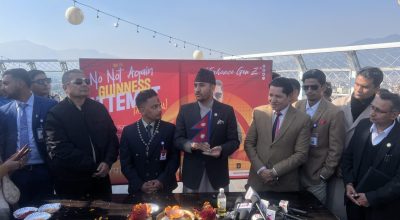
Himanshu Chaudhary
Janakpurdham, July 31: Despite being the second most spoken language in Nepal and the first in Madhes Province, the discourse on Magahi, Hindi and Madhesi languages has obscured the context of determining Maithili as an official language in the province. Although the Language Commission has clearly stated Maithili as the leading language in the province, the context of a contact language has questioned its future.
The discourse of giving priority to Hindi as the lingua franca and Magahi as the mother tongue has created a question mark over the future of the Maithili language. But since the Maithili language is not enlisted as an endangered language in the world-famous reference book, ‘South Asian and the Middle East’, we can at present be rest assured that the language is safe.
Similarly, in the book, Nepali, Maithili and Bhojpuri are mentioned as secure languages. However, a careful analysis indicates that the language probably may not survive in the future. Some have started mentioning casual factors behind death of the Maithili language. Going by history, Maithili language is found to have its spread up to the Kathmandu Valley and Palpa and not being limited to only the Mithila region.
Finding a special place in literature, the language has its own script. The kings of the Sen dynasty also used Maithili as their official language, it has been found. Researchers have confirmed that Malla kings in the Kathmandu Valley used Maithili in plays, poetry and song composition given the advanced status of this language, literature, culture, and art, the melody of the language, and the beauty of expression and flexibility. The language exhibits the ancient dignity of Nepal.
Language of the Mithila region is Maithili. Scholars have claimed that Maithili is the mother tongue of ancient Mithila. According to the Stanza 18 of Sundarkanda of Balmiki’s Ramayan, when Rawan made Sita captive and kept her in the Ashoka Batika, Hanuman had talked with Sita in Maithili.
According to the book entitled ‘History of Maithili Literature’ by Dr Durga Nanda Jha, the existence of Mithila remains since the Vedic era. Environment, vegetation, wildlife described in The Vedas, Puranas, Upanishad, Mimamsha are a match with Mithila. The Mithila state was officially established following the rise of Janaka dynasty, and its capital was Janakpurdham. Historians have mentioned that the tenure of the Janaka dynasty was from 3000 to 600 BC. In between the period, Sita was born. Situated in the middle of the Koshi, Kamala, Bagmati, Gandaki and Ganga rivers, the land is said to be surrounded in the three directions.
The Siddha scriptures written during the eighth century is in Maithili language. The couplets and songs of sage poets of that time like Dak, Bhas and Bhusuppa are still available. Most of the works of the literary figures are available in the Tarai of Nepal. Jyotishwor’s ‘Dhurat Samagam’, the oldest ancient scripture, mentions Maithili language among the languages of the Indo-European language family.
According to linguist Dr Ramawatar Yadav, of 150 manuscripts of plays written between 900 AD and 18th century in the National Archives of Nepal, 115 are in Maithili, 26 in Newari and five in Bangali. So far, as per the confirmation, of 28 languages in the Indo- Aryan community, Maithili is old language behind Marathi.
A survey carried out in the 19th century by George Abraham Grierson has mentioned that Maithili had the independent literary tradition in the Tarai and most parts of Bihar in India. According to research conducted in Simrongadh by historian Dr Tulasiram Vaidhya, the Maithili language received a state patronage during the reign of kings of Karnat dynasty.
From the beginning of the 14th century, the language had wide impacts in places including Kantipur, Lalitpur, Bhaktapur and Banepa. According to history laureate Baburam Acharya, Sen kings used Maithili as an official language.
Mahakabi of Maithili language Vidyapati was already born during the fourth century. Vidyapati, who was born around 1340 AD, composed more than a dozen poems and prose. Even Rabindranath Tagore accepted Vidyapati as the poetry guru. During his stay in Banauli village near Janakpurdham, Vidyapati translated The Bhagawat Gita in Maithili, and wrote a half dozen books, according to existing evidences.
Maithili is found to have been used as an official language in the Kathmandu Valley before Prithivi Narayan Shah conquered the valley. Malla kings would speak in Maithili, and write literature in the language. It seemed Prithivi Narayan restricted the Maithili language and culture, and approved Nepali as an official language.
According to history, king Mahendra in the name of ‘one king one nation, one language and single national dress’ later tried to finish the identity of Maithili language by attacking the language and Maithili culture.
In this situation, there is a need to take the linguistic movement against the threats for the survival of rich Maithili language as a campaign based on history, practice and scientific evidences. It is because relation with the language is connected with culture, civilization, self-esteem and identity. Having faced attacks at the hands of rulers from Shah dynasty in their bid to hold control of power and politics, the Maithili language is seeking its old existence. It has its script, speakers and literary heritage but it is neglected. Although Maithili language has not provided the language speaking people with the ethnic personality and identity, it has enriched literature and culture of the state. Nepali language has a deep impression of Maithili language.
Words referring to places, names, vegetation, food, lifestyle and popular local things used in daily life in the Maithili language are found in the Nepali language. However, the decreasing number of Maithili speakers due to the persecution of the ruling class has posed a serious challenge to the future of the language.
According to the National Census 2078, of the total 124 mother tongues spoken in Nepal, Nepali language accounts for 44.86 percent, Maithili 11.05, Bhojpuri 6.24, Tharu 5.88, Tamang 4.88, Bajjika 3.89, Abadhi 2.66, Newari 2.96, Magar Dhut 2.78 and Doteli 1.7.
Data shows that the number of Maithili speaker is dwindling. Principally, abandoning the mother tongue to embrace other dominant languages being the cause of the dwindling of the language is a matter of concern for Maithili. Additionally, the anger towards the activities of those considering themselves leaders of the society, who have limited the opportunities of the Maithili speakers, is contributing to the dwindling of the language. Such trend has its place at the local level that we cannot deny the bitter truth that Maithili has not been written as the mother tongue in the census by naming Maithili as typical calling the language spoken by a particular ethnicity, and naming other languages in the census.
Culture refers to the use of language, livelihoods, governance, and achievement that are passed down from one generation to another. Nepali culture is a wholesomeness of the culture that developed from time to time on the banks of the Saptakoshi, Saptagandaki and Saptakarnali rivers that flow from the peaks of the Himalaya to the vast plain of the Tarai Madhes.
Mithili culture lying between Koshi and Gandaki has its own significance. Agneya caste coming from across the Ganga and Arya caste coming from across the Sadanira (Gandai) with fire energised the greater Aranya.
Mithili culture was born from the combination of folk culture and agricultural culture. Knowledge, action and morals are its essences. This includes hereditary skills, objects, perception, processes, and practices and values. So, culture is considered to be a way of life and an indicator of civilisation. Under this, what we do has the manifestation of our culture. It should be taken as the meaning of the awakening of cleanliness, harmony and sensitivity of Maithili culture.
The neglect of the current federal and provincial governments towards Maithili language is a part of its dwindling. Factors like most of Maithili speaking youth being half Maithili speakers, teachers encouraging so called substandard and non-standard Maithili, and parents turning their children away from their mother tongue in the name of their development due to the biased analysis of Maithili as clearly impure, typical, uncivilised etc., and social, political, cultural and psychological context.
Therefore, there is a need for Maithili speakers to show their deepest respect for their language, the introduction, selection and use of Maithili language in school curriculums, the comprehensive language plan and a sociological survey of the Maithili speaking regions. RSS
[Chaudhary is a journalist and a researcher of Maithili language, literature.]
















